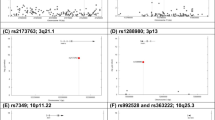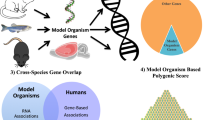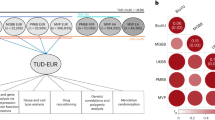Abstract
To date, most genetic association studies of tobacco use have been conducted in European American subjects using the phenotype of smoking quantity (cigarettes per day). However, smoking quantity is a very imprecise measure of exposure to tobacco smoke constituents. Analyses of alternate phenotypes and populations may improve our understanding of tobacco addiction genetics. Cotinine is the major metabolite of nicotine, and measuring serum cotinine levels in smokers provides a more objective measure of nicotine dose than smoking quantity. Previous genetic association studies of serum cotinine have focused on individual genes. We conducted a genetic association study of the biomarker in African American (N=365) and European American (N=315) subjects from the Coronary Artery Risk Development in Young Adults study using a chip containing densely-spaced tag SNPs in ∼2100 genes. We found that rs11187065, located in the non-coding region (intron 1) of insulin-degrading enzyme (IDE), was the most strongly associated SNP (p=8.91 × 10−6) in the African American cohort, whereas rs11763963, located on chromosome 7 outside of a gene transcript, was the most strongly associated SNP in European Americans (p=1.53 × 10−6). We then evaluated how the top variant association in each population performed in the other group. We found that the association of rs11187065 in IDE was also associated with the phenotype in European Americans (p=0.044). Our top SNP association in European Americans, rs11763963 was non-polymorphic in our African American sample. It has been previously shown that psychostimulant self-administration is reduced in animals with lower insulin because of interference with dopamine transmission in the brain reward centers. Our finding provides a platform for further investigation of this, or additional mechanisms, involving the relationship between insulin and self-administered nicotine dose.
Similar content being viewed by others
Log in or create a free account to read this content
Gain free access to this article, as well as selected content from this journal and more on nature.com
or
References
Baskin DG, Schwartz MW, Sipols AJ, D'Alessio DA, Goldstein BJ, White MF (1994). Insulin receptor substrate-1 (IRS-1) expression in rat brain. Endocrinology 134: 1952–1955.
Bergen AW, Caporaso N (1999). Cigarette smoking. J Natl Cancer Inst 91: 1365–1375.
Caraballo RS, Giovino GA, Pechacek TF, Mowery PD, Richter PA, Strauss WJ et al. (1998). Racial and ethnic differences in serum cotinine levels of cigarette smokers: Third National Health and Nutrition Examination Survey, 1988–1991. JAMA 280: 135–139.
Cashman JR, Park SB, Yang ZC, Wrighton SA, Jacob 3rd P, Benowitz NL (1992). Metabolism of nicotine by human liver microsomes: stereoselective formation of trans-nicotine N'-oxide. Chem Res Toxicol 5: 639–646.
Clark PI, Gautam SP, Hlaing WM, Gerson LW (1996). Response error in self-reported current smoking frequency by black and white established smokers. Ann Epidemiol 6: 483–489.
English PB, Eskenazi B, Christianson RE (1994). Black-white differences in serum cotinine levels among pregnant women and subsequent effects on infant birthweight. Am J Public Health 84: 1439–1443.
Farris W, Leissring MA, Hemming ML, Chang AY, Selkoe DJ (2005). Alternative splicing of human insulin-degrading enzyme yields a novel isoform with a decreased ability to degrade insulin and amyloid beta-protein. Biochemistry 44: 6513–6525.
Farris W, Mansourian S, Chang Y, Lindsley L, Eckman EA, Frosch MP et al. (2003). Insulin-degrading enzyme regulates the levels of insulin, amyloid beta-protein, and the beta-amyloid precursor protein intracellular domain in vivo. Proc Natl Acad Sci USA 100: 4162–4167.
Farris W, Mansourian S, Leissring MA, Eckman EA, Bertram L, Eckman CB et al. (2004). Partial loss-of-function mutations in insulin-degrading enzyme that induce diabetes also impair degradation of amyloid beta-protein. Am J Pathol 164: 1425–1434.
Garcia BG, Wei Y, Moron JA, Lin RZ, Javitch JA, Galli A (2005). Akt is essential for insulin modulation of amphetamine-induced human dopamine transporter cell-surface redistribution. Mol Pharmacol 68: 102–109.
Gorber SC, Schofield-Hurwitz S, Hardt J, Levasseur G, Tremblay M (2009). The accuracy of self-reported smoking: a systematic review of the relationship between self-reported and cotinine-assessed smoking status. Nicotine Tob Res 11: 12–24.
Haiman CA, Stram DO, Wilkens LR, Pike MC, Kolonel LN, Henderson BE et al. (2006). Ethnic and racial differences in the smoking-related risk of lung cancer. N Eng J Med 354: 333–342.
Haley NJ, Axelrad CM, Tilton KA (1983). Validation of self-reported smoking behavior: biochemical analyses of cotinine and thiocyanate. Am J Public Health 73: 1204–1207.
He Y, Bergen AW, Hops H, Andrews JA, Tildesley E, Lessov-Schlaggar CN et al. (2009). Genome-wide linkage of cotinine pharmacokinetics suggests candidate regions on chromosomes 9 and 11. Am J Med Genet B Neuropsychiatr Genet 150B: 554–559.
Hodgkinson CA, Yuan Q, Xu K, Shen P-H, Heinz E, Lobos EA et al. (2008). Addictions biology: haplotype-based analysis for 130 candidate genes on a single array. Alcohol Alcohol 43: 505–515.
Huang L, Li Y, Singleton AB, Hardy JA, Abecasis G, Rosenberg NA et al. (2009). Genotype-imputation accuracy across worldwide human populations. Am J Hum Genet 84: 235–250.
Hukkanen J, Jacob 3rd P, Benowitz NL (2005). Metabolism and disposition kinetics of nicotine. Pharmacol Rev 57: 79–115.
Jarvis M, Tunstall-Pedoe H, Feyerabend C, Vesey C, Salloojee Y (1984). Biochemical markers of smoke absorption and self reported exposure to passive smoking. J Epidemiol Community Health 38: 335–339.
Keating BJ, Tischfield S, Murray SS, Bhangale T, Price TS, Glessner JT et al. (2008). Concept, design and implementation of a cardiovascular gene-centric 50 k SNP array for large-scale genomic association studies. PLoS ONE 3: e3583.
Keskitalo K, Broms U, Heliovaara M, Ripatti S, Surakka I, Perola M et al. (2009). Association of serum cotinine level with a cluster of three nicotinic acetylcholine receptor genes (CHRNA3/CHRNA5/CHRNB4) on chromosome 15. Hum Mol Genet 18: 4007–4012.
Kurochkin IV, Goto S (1994). Alzheimer's beta-amyloid peptide specifically interacts with and is degraded by insulin degrading enzyme. FEBS Lett 345: 33–37.
Liu JZ, Tozzi F, Waterworth DM, Pillai SG, Muglia P, Middleton L, et al., Wellcome Trust Case Control Consortium (2010). Meta-analysis and imputation refines the association of 15q25 with smoking quantity. Nat Genet 42: 436–440.
Miller BC, Eckman EA, Sambamurti K, Dobbs N, Chow KM, Eckman CB et al. (2003). Amyloid-beta peptide levels in brain are inversely correlated with insulysin activity levels in vivo. Proc Natl Acad Sci USA 100: 6221–6226.
Musunuru K, Lettre G, Young T, Farlow DN, Pirruccello JP, Ejebe KG et al. (2010). Candidate gene association resource (CARe): design, methods, and proof of concept. Circ Cardiovas Genet 3: 267–275.
Mwenifumbo JC, Zhou Q, Benowitz NL, Sellers EM, Tyndale RF (2010). New CYP2A6 gene deletion and conversion variants in a population of Black African descent. Pharmacogenomics 11: 189–198.
Nakajima M, Yamamoto T, Nunoya K, Yokoi T, Nagashima K, Inoue K et al. (1996). Role of human cytochrome P4502A6 in C-oxidation of nicotine. Drug Metab Dispos 24: 1212–1217.
Owens WA, Sevak RJ, Galici R, Chang X, Javors MA, Galli A et al. (2005). Deficits in dopamine clearance and locomotion in hypoinsulinemic rats unmask novel modulation of dopamine transporters by amphetamine. J Neurochem 94: 1402–1410.
Pattishall EN, Strope GL, Etzel RA, Helms RW, Haley NJ, Denny FW (1985). Serum cotinine as a measure of tobacco smoke exposure in children. Am J Dis Child 139: 1101–1104.
Perez-Stable EJ, Herrera B, Jacob 3rd P, Benowitz NL (1998). Nicotine metabolism and intake in black and white smokers. JAMA 280: 152–156.
Price AL, Patterson NJ, Plenge RM, Weinblatt ME, Shadick NA, Reich D (2006). Principal components analysis corrects for stratification in genome-wide association studies. Nat Genet 38: 904–909.
Purcell S, Neale B, Todd-Brown K, Thomas L, Ferreira MA, Bender D et al. (2007). PLINK: a tool set for whole-genome association and population-based linkage analyses. Am J Hum Genet 81: 559–575.
Qiu W, Walsh D, Ye Z, Vekrellis K, Zhang J, Podlisny M et al. (1998). Insulin-degrading enzyme regulates extracellular levels of amyloid beta-protein by degradation. J Biol Chem 273: 32730–32738.
Qiu WQ, Folstein MF (2006). Insulin, insulin-degrading enzyme and amyloid-beta peptide in Alzheimer's disease: review and hypothesis. Neurobiol Aging 27: 190–198.
Ries L, Melbert D, Krapcho M, Stinchcomb D, Howlader N, Horner M et al. (2008). SEER Cancer Statistics Review, 1975–2005. National Cancer Institute: Bethesda, MD.
Smith RM, Alachkar H, Papp AC, Wang D, Mash DC, Wang J-C et al. (2011). Nicotinic alpha-5 receptor subunit mRNA expression is associated with distant 5′ upstream polymorphisms. Eur J Hum Genet 19: 76–83.
Sugano T, Yanagita T, Yokoo H, Satoh S, Kobayashi H, Wada A (2006). Enhancement of insulin-induced PI3K/Akt/GSK-3beta and ERK signaling by neuronal nicotinic receptor/PKC-alpha/ERK pathway: up-regulation of IRS-1/-2 mRNA and protein in adrenal chromaffin cells. J Neurochem 98: 20–33.
Swan GE, Lessov-Schlaggar CN, Bergen AW, He Y, Tyndale RF, Benowitz NL (2009). Genetic and environmental influences on the ratio of 3′hydroxycotinine to cotinine in plasma and urine. Pharmacogenetics Genomics 19: 388–398.
Taguchi A, Wartschow LM, White MF (2007). Brain IRS2 signaling coordinates life span and nutrient homeostasis. Science 317: 369–372.
Thorgeirsson TE, Geller F, Sulem P, Rafnar T, Wiste A, Magnusson KP et al. (2008). A variant associated with nicotine dependence, lung cancer and peripheral arterial disease. Nature 452: 638–642.
Thorgeirsson TE, Gudbjartsson DF, Surakka I, Vink JM, Amin N, Geller F et al. (2010). Sequence variants at CHRNB3-CHRNA6 and CYP2A6 affect smoking behavior. Nat Genet 42: 448–453.
Tobacco and Genetics Consortium (2010). Genome-wide meta-analyses identify multiple loci associated with smoking behavior. Nat Genet 42: 441–447.
VanVunakis H, Gjika H, Langone J (1987). Method 16-Radioimmunoassay for nicotine and cotinine. In: O'Neill I, Brunnemann K, Dodet B, Hoffman D (ed). Environmental Carcinogens Methods of Analysis and Exposure Measurement. Volume 9-Passive Smoking, IARC, pp 317–330.
Vekrellis K, Ye Z, Qiu WQ, Walsh D, Hartley D, Chesneau V et al. (2000). Neurons regulate extracellular levels of amyloid beta-protein via proteolysis by insulin-degrading enzyme. J Neurosci 20: 1657–1665.
Vepsalainen S, Parkinson M, Helisalmi S, Mannermaa A, Soininen H, Tanzi RE et al. (2007). Insulin-degrading enzyme is genetically associated with Alzheimer's disease in the Finnish population. J Med Genet 44: 606–608.
Wagenknecht LE, Cutter GR, Haley NJ, Sidney S, Manolio TA, Hughes GH et al. (1990). Racial differences in serum cotinine levels among smokers in the Coronary Artery Risk Development in (Young) Adults study. Am J Public Health 80: 1053–1056.
Wang J, Kim J, Donovan D, Becker K, Li M (2009). Significant modulation of mitochondrial electron transport system by nicotine in various rat brain regions. Mitochondrion 9: 186–195.
Wang JC, Li MD (2010). Common and unique biological pathways associated with smoking initiation/progression, nicotine dependence, and smoking cessation. Neuropsychopharmacology 35: 702–719.
Wang K, Hackett JT, Cox ME, Van Hoek M, Lindstrom JM, Parsons SJ (2004). Regulation of the neuronal nicotinic acetylcholine receptor by SRC family tyrosine kinases. J Biol Chem 279: 8779–8786.
Williams JM, Owens WA, Turner GH, Saunders C, Dipace C, Blakely RD et al. (2007). Hypoinsulinemia regulates amphetamine-induced reverse transport of dopamine. Plos Biol 5: e274.
Acknowledgements
We thank the staff and participants of the CARDIA study for their important contribution. We thank James Wilson, MD, for his outstanding logistical support in the completion of this project and Deb Farlow, PhD, for her important support of the working group. Ajna Hamidovic received an MD Scientist Fellowship in Genetic Medicine (Northwestern Memorial Foundation) and the National Research Service Award F32DA024920 (NIH/NIDA; Ajna Hamidovic). Eric Jorgenson received the Dr Bonnie Spring's Professional Account at Northwestern Feinberg School of Medicine, KL2 RR024130-02 (Eric Jorgenson). CARe wishes to acknowledge the support of the National Heart, Lung and Blood Institute and the contributions of the research institutions, study investigators, field staff, and study participants in creating this resource for biomedical research (NHLBI contract number HHSN268200960009C). CARDIA is supported by the National Heart, Lung, and Blood Institute (NHLBI) in collaboration with Northwestern University (N01-HC48049), University of Alabama at Birmingham (N01-HC95095 & N01-HC48047), University of Minnesota (N01-HC48048), and Kaiser Foundation Research Institute (N01-HC48050).
Author information
Authors and Affiliations
Corresponding author
Ethics declarations
Competing interests
Dr Neal Benowitz has served as a consultant to Pfizer and other pharmaceutical companies that develop and/or market smoking cessation medications. He also has served as a paid expert witness in litigation against tobacco companies. Dr Andrew Bergen received compensation from the Center for Scientific Review, the NIH for study section service (2009–2011) and compensation for service as an Advisory Board Member for the National Center for Health Professional Education in Genetics (2009–2010) in the last 3 years. The remaining authors do not have any potential conflicts of interest to report.
Additional information
Supplementary Information accompanies the paper on the Neuropsychopharmacology website
Rights and permissions
About this article
Cite this article
Hamidovic, A., Goodloe, R., Bergen, A. et al. Gene-Centric Analysis of Serum Cotinine Levels in African and European American Populations. Neuropsychopharmacol 37, 968–974 (2012). https://doi.org/10.1038/npp.2011.280
Received:
Revised:
Accepted:
Published:
Issue date:
DOI: https://doi.org/10.1038/npp.2011.280
Keywords
This article is cited by
-
Metabolic and Addiction Indices in Patients on Opioid Agonist Medication-Assisted Treatment: A Comparison of Buprenorphine and Methadone
Scientific Reports (2020)
-
Reduction of smoking urges with intranasal insulin: a randomized, crossover, placebo-controlled clinical trial
Molecular Psychiatry (2017)
-
Total Exposure Study Analysis consortium: a cross-sectional study of tobacco exposures
BMC Public Health (2015)



